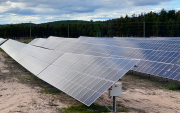This is the sixth publication in Climate and energy policy advancements: Eliminating diesel in Canada’s remote communities, a series providing insights, details, and analysis of each of the specific policies we advocate for under our Renewables in Remote Communities (RiRC) program and the Indigenous Off-diesel Initiative (IODI). This blog builds on a previous piece from the Pembina Institute, The future of the electric utility in Canada’s remote communities.
For remote communities to successfully transition to a clean energy future, utilities must evolve from providing power through diesel generation to facilitating a more diverse and environmentally friendly energy mix. Core to this evolution is to address the way in which utilities secure revenue, which currently acts as an obstacle to a cleaner, more independent energy future. The standard utility business model in place throughout Canada’s remote communities is known as the Cost of Service (CoS) model. Its configuration acts as a deterrent to the purchase of renewable energy from independent power producers, to the adoption of energy efficiency measures, and, by limiting energy decision-making opportunities, to energy self-determination for Indigenous peoples in remote communities still heavily reliant on diesel fuel.
The Cost of Service Model (CoS)
Utilities generate revenue from the electricity rates charged to consumers. Rates are determined in part by assessing the costs of the capital requirements of a utility’s assets, which in turn informs how much to charge back to the consumer; a profit margin is also built into the rate charged. Essentially, this is the CoS model. As per the figure below, the total amount of revenue a utility collects is calculated to cover the sum of operating costs, capital costs, and profit. Operating costs and profit undergo minor fluctuation and remain fairly consistent over time. However, utilities can increase their revenue by owning more assets.

The CoS model incentivizes utilities to both sell more energy and own more assets, as doing so increases revenue. Conversely, utilities do not benefit from promoting energy efficiency which decreases demand. The CoS model means that utilities do not financially benefit from entering into a Power Purchase Agreement (PPA) with an Independent Power Producer (IPP) as the IPP owns the assets and not the utility.
The consequence of the CoS model is that utility objectives do not align with provincial, territorial, and federal goals to address climate change. To address this, the business model guiding how utilities function needs to change. Furthermore, utility responsibilities need to accommodate demand from customers for low-carbon energy and innovation.

Utilities servicing remote communities are starting to feel the pressure of consumer preferences for renewable energy and improved environmental performance. Indigenous communities are pushing for energy sovereignty and are developing low-carbon solutions to establish their independence, such as becoming independent power producers of renewable energy and implementing energy efficiency initiatives.
Independent projects, however, mean lost revenue for utilities. To compensate, utilities, and the regulatory bodies that govern them, will need to explore other options for revenue generation, ones that align with climate action goals and offer pathways that will reduce diesel dependency.
Unique challenges faced by northern utilities
While alternative utility business models exist, they must be evaluated against the unique constraints experienced by utilities servicing remote communities, such as:
- The need to offer affordable energy – Energy affordability is of paramount importance in remote communities.
- A small customer base – Without raising rates, there is little if any opportunity for revenue growth due to the small pool of ratepayers in remote communities.
- Diesel subsidies – High energy costs, a small customer base, and scarce funds for utility capital spending mean that utilities have come to depend on subsidies.
- Internal capacity – Utilities often do not have sufficient staffing and capacity to research, evaluate, and run pilots of new business models, or to fully explore how to integrate renewable energy and energy efficiency into their operations.
- Interconnection limitations – It is not cost effective for northern microgrids to interconnect with larger integrated grid networks; consequently, the utilities operating microgrids do not have access to wholesale markets where electricity suppliers offer competitive rates from varied energy sources that larger networks can purchase from.
- Infrastructure – Substandard telecommunication infrastructure limits opportunities to add smart grid technologies such as smart meters which track how much electricity is used and when, thus allowing consumers to adjust their usage and networks to note patterns of power usage and need.
- Systems redundancy – When renewable generation is added, many diesel systems will have to remain online as backup.
Pathways for change
Utility business models can target one or a combination of areas to transform current practices:
- Change how rates are set – Regulatory bodies can explore other means of compensating utilities for their services as well as means of generating revenue from infrastructure they do not own. Doing so would allow utilities to prioritize renewable electricity from IPPs.
- DER/energy efficiency implementation – Regulators can design ways to incentivize utilities to implement energy efficiency measures, such as offering benefits to utilities for saving a pre-determined amount of energy. For example, the benefits to utilities could kick in when the targeted amount of energy saved is met.
- Supporting Indigenous reconciliation – Existing utilities can recognize Indigenous utilities as legal actors that can supply energy to Indigenous communities. This will also help advance Indigenous energy sovereignty.
- Alignment of utility operations with government climate policy objectives – To achieve federal, provincial, and territorial climate and environmental goals, utilities must be able to realize financial benefits through improving environmental performance.
Building bridges
Reforming the business models that determine how utilities operate and set rates can create opportunities for Indigenous participation. It also offers new ways for Crown utilities to implement some of the Truth and Reconciliation Commission’s Calls to Action and to recognize, through practice, the United Nations Declaration on the Rights of Indigenous People. Governments can push utilities to reduce GHG emissions by purchasing clean energy from IPPs, implementing energy efficiency programs, developing climate action efforts, and prioritizing Indigenous peoples in their climate plans.
Next up: An overview of innovative energy service models and how they can be applied in remote Indigenous communities.

Climate and energy policy advancements: Eliminating diesel in Canada’s remote communities
Publications in this series:
- Rethinking energy policy in Canada’s remote communities
- How to boost renewable energy integration in remote communities
- What’s a fair and equitable price for renewable energy in remote communities?
- Better government policies will unlock the cash remote Indigenous communities need for clean energy
- Reducing emissions from diesel generators in remote communities
- When business-as-usual is a barrier to clean energy
- From diesel dependency to energy empowerment
- Three clean energy options that could help replace diesel
- Remote communities transitioning to clean energy need better housing
- How remote communities should be included in the push to electrify transportation
- Government action on UNDRIP and the clean energy transition










